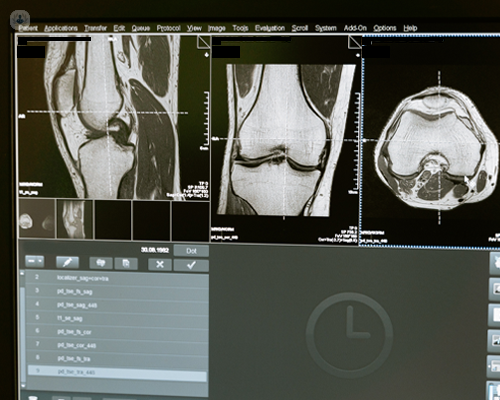Knee cartilage repair: microfracture or nanofracture procedure?
Escrito por:In order to regenerate knee cartilage, there are several techniques that use bleeding in order to assist in the healing process. One of them is microfracture, which requires damaged matter to be completely cleared in order to pierce the bone, releasing blood and marrow to form new cartilage.
Leading consultant orthopaedic and trauma surgeon, Mr Turab Syed, leads us through nanofracture, a new technique that’s a similar process to microfracture, done using smaller instruments, and the differences between the two.

What are the symptoms of knee cartilage damage?
The consensus on knee cartilage damage is a pain that can be variable. It manifests as a dull ache which is intermittently present to a constant ache which is quite sore and significant and can stop you from doing your normal daily activities or sports.
Also, very rarely, people can have symptoms of locking or 'giving way'. Locking can be compared to having marbles stuck in a cog wheel which will stop the whole thing. A small piece of cartilage is broken from either the joint surface or from the meniscus, which gets trapped in between the joint. This would result in locking of the joint and one would not be able to either fully straighten or bend the knee and they would have to shake it to get it moving, which is associated with pain - or can be painless.
The other is the symptom of ‘giving way’. Once you have cartilage damage behind the knee cap, you suddenly find that when walking your knee tends to give way. Most of the time people are able to save themselves from falling onto the ground. This pain can be momentarily present. Another sign of cartilage damage is if you have been doing exercise, your knee would swell up and become painful.
Another would be that if you have been driving for a long time or sat down for a while, for example; at the movies, when you try to stand up you find that your knee is not as stable as you expect it to be. In conclusion, the symptoms of knee cartilage damage are pain, locking and giving way of the knee.
Why can't knee cartilage that’s damaged repair itself and if it's left untreated, what complications might occur?
The knee cartilage cannot repair itself as we mature. The stem cell which is part of the cartilage loses its regenerative potential. That's why we end up doing the total knee replacement because the cartilage keeps on getting worse. An analogy is having a car tyre which is brand new and as time goes by, with use the car tyre will wear out similarly to the knee joint will wear one with use. Like how we can get the re-treading of the car tyre if we catch it early enough and they are still in the legal limits, we can use it for a little bit longer. But if the tyre is allowed to go down below the legal limit, then one would not be able to use it or get it re-treaded.
Similarly, if we have arthritis in the knee which is picked up earlier on and is treated appropriately, i.e., by targeted physiotherapy plus minor use of stem cells, platelet-rich plasma or painkillers, it can be improved. Sometimes when we need to do taping of the knee like in the conditions which involve the patella-femoral joint, it delays the complications.
The most dreaded complication of the formation of cartilage damage is development of arthritis. This could be either rheumatoid arthritis as part of inflammatory arthritis or it could be osteoarthritis if someone like me who is heavy and has got a high BMI and weight. Or it could be similar to post-traumatic arthritis where the cartilage was damaged as a result of the fracture or a piece of cartilage was missed. Like a divot on a golf course, which if left like this, it would lead to further damage.
What is the micro-fracture technique?
Micro-fracture technique is the process whereby holes are made in the area where the cartilage is damaged. These holes are made either through a special pick or using a drill. Some people use a Kirshner wire (k-wire) as well.
The idea is that we break deep into the bone to allow the blood to seep from its’ deeper layers along with the marrow, which can contain some stem cells to come to the surface and then they try to form kind of cartilage which is not the normal cartilage but it provides a cartilage cover over that divot of the grass which if not, would have gone off with a shot from a club.
So, in simple terms we can say that the bone marrow and the blood has seeped through, making several holes in that area where the cartilage was lost and the body makes fibro cartilage. Those holes are filled up with fibro cartilage (which is the inferior form of cartilage than our normal joint cartilage, which is high-line cartilage that has a more cushioning effect). It at least provides the cover.
The difference between a high-line cartilage and fibro cartilage can be compared to having a brand new, plush, plump, spring-coiled mattress which is your high-line cartilage and having a very old mattress where the springs have stopped working, which would still be better than sleeping on the floor.
What is the nanofracture technique? Is it widely available?
Nanofracture is the next step up from the micro fracture because with micro fracture, the awl we are using is bigger in size and the wire we are using is about 1.2 to 1.5 millimetres. And because we are making these holes in that area of bone, we can only make X number of holes, say for about one square centimetre area say we'd be able to drill five to six holes. Only the marrow from those five to six holes would seep out.
When we are doing the nanofracturing, the key is that, the size of the hole from the drill is much thinner and with the cubic centimetre area, we would be able to say, make twelve holes. Because we are able to make more holes, more bone marrow and stem cells would come out of the bone. Still, it would try to make fibro cartilage but not high-line cartilage.
When we argue that we are making more holes because their size is smaller but we would be getting exactly the same amount of stem cells and bone marrow coming out; this is a very fair point. The way to explain it is that by making bigger holes, we do get the same amount of stem cells and bone marrow coming out but the gap between those holes is bigger and its difficult for the body to make a fibral clot which can hold it well. By having lots of holes from where the blood and marrow would seep out, this would give you a stronger hold in that hole because the gap between the different plugs would be less.
A simple analogy would be that if you have to stick something onto a wall with the screw holes going through it, probably six holes would hold a picture very well but in the same picture if you put twelve screws going through the same surface area those would have an even better chance of holding the picture on to the wall.
Is it widely available?
It is generally available through centres that offer it but it's not available everywhere because of the in-wall instruments which have to be ordered, plus the kit and the associated cost. There are some specialist centres like ours where it is available. This has been widely used in Germany and research has shown that this is a slightly superior technique to micro fracturing.
Which of the two procedures has a better outcome in restoring damaged knee cartilage?
It is very difficult to be absolutely precise but the recent evidence from nanofracture techniques has shown nanofracture has a slightly superior outcome compared to microfracture. However, I must stress that both procedures tend to make the fibro cartilage than the high-line cartilage.
There's evidence in medical literature which shows that this innovative repair technique of nanofracture is not only effective but is low in deeper perforation into deeper layers of the bone. Not only is there less fragmentation of the bone and less compaction of the bone in between the holes and compared to microfracture but it results in better restoration of the normal subchondral bony architecture after six months.
Nanofracture allows the immediate formation of a super clot which results in improved recruitment of the stem cells, compared to microfracturing. Also, as the nanofracture doesn't cause compression of the bone tubercle, it results in an open number of canals that communicate with the nanofracture channel.
References:
2016 Aug 18;4(2):87-93. doi: 10.11138/jts/2016.4.2.087. eCollection Apr-Jun 2016.
Subchondral bone remodeling: comparing nanofracture with microfracture. An ovine in vivo study
PMID: 27602348 PMCID: PMC4993551 DOI: 10.11138/jts/2016.4.2.087
If you have queries regarding damaged knee cartilage and related conditions, get in touch with Mr Turab Syed for expert advice. You can find his Top Doctors profile here.


